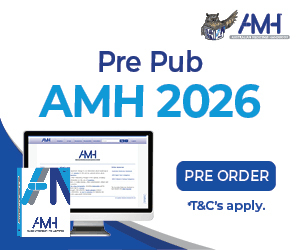Nurse Practitioner Skye Coote is the Nursing Coordinator of the Melbourne Mobile Stroke Unit at the Royal Melbourne Hospital. The first of its kind in Australia, the unit attends to patients with suspected stroke and provides immediate treatment.
The ANMJ spoke to Skye about her unique role and ongoing drive to improve outcomes for Melburnians who experience stroke.
What is the Melbourne Mobile Stroke Unit and what is your scope of practice within the team?
The MSU is a specialised ambulance that has a built-in CT scanner and carries a multidisciplinary acute stroke team consisting of two paramedics, a radiographer, a neurologist, and a stroke nurse.
We get sent alongside a standard ambulance to 000 calls for suspected stroke. We’re able to scan, diagnose and treat patients in their driveway, all before taking them to hospital.
At the moment, the neurologist is on-board the MSU, so my current scope of practice involves assisting with performing comprehensive stroke assessments, ordering non-contrast CT imaging, and partnering with the neurologist to provide the appropriate pre-hospital treatment for the patient’s stroke type.
The neurologist will be coming off the vehicle soon though and will consult via telemedicine. While the doctor will continue to consult on all cases, the NP will be the sole stroke expert physically on-board the MSU, and will therefore have greater on-scene autonomy in triaging cases for the MSU to attend, performing assessments, ordering investigations and determining differential diagnosis.
When did you develop a passion for improving stroke care and what education did you have to undertake to work in this field?
I never expected to find myself working in stroke. I offered to cover a roster shortfall and never left. From day one, the role spoke to me and being able to use both my critical care and stroke skills to rapidly assess and treat patients in the Emergency Department alongside the fantastic ED and Code Stroke teams was great.
I already had a Graduate Diploma in Critical Care nursing, but I undertook my Master of Nursing degree to become a Nurse Practitioner.
Even during my Master’s degree, I felt I needed more stroke specific education, so I completed two international courses specialising in acute stroke management, one of which is taught at the level of a stroke fellow. Following these courses, I sat two very daunting exams (through the Association of Neurovascular Clinicians) to become credentialled as a Neurovascular Registered Nurse and (Australia’s only) Advanced Neurovascular Clinician.
What does a typical day on the job look like?
I start at 7am but am usually in earlier to catch up on paperwork. The team meets at the MSU at 7.30am, where we check and stock our equipment. We go into service at 8am and wait for that first call.
We get called out to about eight cases a day (sometimes up to 15-16), so we spend a lot of time on the road. Not all of these cases end up being strokes, but we assess upwards of 2-3 patients per day.
On scene, one paramedic, the neurologist and nurse assess the patient, while the radiographer and second MSU paramedic prepare the MSU and CT scanner. While many of the on-scene tasks are interchangeable between the team, in general, the doctor assess the patient and makes a scanning decision, while the nurse determines the stroke and medical history and performs a treatment safety screen.
If the patient is alone, the nurse and paramedics have to track down family, a GP or anyone else who might be able to tell us about the patient and their medical history – there is a lot of detective work required in the role.
If the patient requires a scan, the paramedics extricate the patient and load them into the MSU, where the radiographer performs the scan. The doctor is able to immediately see and interpret the scans so a rapid treatment decision can be made.
Based on all of this, the doctor orders treatment, which the nurse and the paramedics prepare and administer before securing the patient for transport to hospital.
What kind of outcomes has the Stroke Unit delivered since beginning in 2017?
We have had an incredible impact. We have significantly reduced the time to treatment for stroke therapies, which is proven to improve patient outcomes; our thrombolysis times are approximately half that of the average Australian hospital.
By scanning patients pre-hospital, we can identify those who need specialist stroke treatment (like thrombectomy or neurosurgery that aren’t available at every hospital) and transport them directly to those centres, reducing the need for subsequent inter-hospital transfers – this clearly has enormous benefit to our patients by eliminating unnecessary delays in their care.
If patients do need hospital-based treatment, our pre-hospital notification allows the in-patient team to prepare for the patient’s arrival, meaning the usual in-hospital treatment delays are further reduced.
What’s been the most memorable day working with the Stroke Unit?
One that stands out is not for the obvious reasons. We had just finished handing over a patient at hospital who we had thrombolysed when we were called to the next case.
We attended a middle-aged gentleman who had just arrived on holiday in Australia with his wife. It was their dream trip. They had dropped their bags at the hotel and headed straight out for lunch when he had his stroke.
We treated him and transported him to hospital, but it was his wife who made the impact on me. Here was this woman, literally off a plane three hours earlier, alone in a hospital on the other side of the world, dealing with her husband’s devastating stroke.
She had no SIM card for her phone, no cellular data, no support other than the MSU team and the hospital staff. That night when she finally left the hospital, she went back to the hotel room where her husband’s suitcase laid, still waiting to be unpacked. When this remarkable woman eventually went back home, she proceeded to work with her local stroke associations to raise money to support stroke care.
Sometimes it’s easy to get caught up in the tasks and the busyness of the job, but this patient and his wife represent the human element, the faces behind the stroke. They are the reason I am proud to be a nurse, and their story will stay with me always.
What do you love most about the job?
Stroke is one of the most frightening medical conditions a patient can have; being left disabled is feared more than death by so many people. So being able to attend, treat and witness a patient getting better, all within minutes of their stroke starting is just incredible.
What advice would you give students or early career nurses considering a role in this field?
Go for it! I think the single best thing about nursing as a career is it can take you anywhere, you are never pigeon-holed into one career. If you try it and it’s not for you, move on, but in the meantime you will have learnt so much about the brain, stroke and patient care which will only serve you well in the future.
Right now stroke is so dynamic, we are literally re-writing the manual on stroke care.
I would recommend joining the Acute Stroke Nurses Education Network (ASNEN), the peak professional nursing body in Australian stroke care (which I co-chair) which is a not-for-profit registered charity that provides free education and support to stroke nurses (https://asnen.org/)/
Also look into stroke specific courses such as a Post Graduate Certificate/Diploma or the international Neurovascular Education and Training in Stroke Management and Reperfusion Therapies courses (NET SMART https://www.learnstroke.com/ ) which are fantastic. I am a firm believer in mentoring fellow nurses, so if anyone wants help, I am happy to be contacted via ASNEN or email on Skye.Coote@mh.org.au








